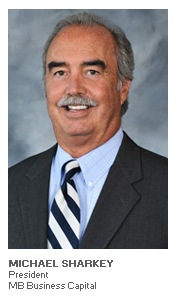
Much has been written of late regarding the impact alternative lenders and other nonbank finance companies have had on the commercial finance landscape. Since this is the season of traditions, ABL Advisor thought it a good time to speak with a more traditional player in the ABL marketplace … and who fits the bill better in that category than MB Business Capital’s Michael Sharkey?
A self-admitted proponent of “bare knuckle ABL,” Sharkey tells it like it is with regard to the dynamics these lenders are encountering in financing middle-market borrowers. In the following exclusive interview, Sharkey brings both the depth and breadth of his professional experience in sharing his views on the current environment as well as what the more traditional ABL players can expect in the coming year.
ABL Advisor:In terms of the traditional asset-based lending borrower sectors such as manufacturing and distribution, what are these corporate borrowers looking for from their asset-based lenders in today’s environment?

Michael Sharkey: In the middle market, we’re seeing very little growth for borrowers in the manufacturing and distribution sectors. If you look at our customer base, those borrowers who were around at the beginning of this year are actually borrowing less today than they did in January. We did an analysis of our business last year and from January to December there was very little growth … something in the range of 2%. Basically, they were paying down debt and today, they don’t seem to be particularly preoccupied with needing liquidity. And since the classic use of the ABL product is to finance growth, it stands to reason that they aren’t seeing much in the way of growth in their businesses. So, what do they want from us? They want a stable, reliable lender at a low rate.
ABL Advisor: Is the same true for the private equity players that utilize asset-based lending structures in these sectors?
Sharkey: If you look at the private equity players who are buying companies in these sectors, the multiples are sky-high right now. They have an opposite view – all they want is liquidity and they are willing to pay for it. But there’s an interesting dichotomy in place. At MB Financial, we have a fair number of deals going on and from what I can tell; I think the strategic buyers have the advantage because today’s multiples are so high. Think about it … if you have no growth, how do you justify these high multiples? Aside from the fact that these private equity groups have money that they need to deploy or lose, it’s really the strategic buyers that can drive up EBITDA through synergies. So we’re seeing that in the case of our customers that are being sold, there’s a strategic buyer in place. And, these strategic buyers generally don’t need financing.
All this makes today’s ABL marketplace a bit interesting and difficult to say the least from the perspective that customers are looking at those high multiples and in turn, are selling to these strategic buyers who don’t need financing. Or they are going to a private equity firm that is trying to maximize liquidity by bringing in a cash-flow lender.
This is not only true of the larger transactions; it’s true of the smaller deals as well. Instead of the alternative lenders, the business development companies [BDCs] and the hedge funds that we see on the bigger deals; we’re seeing the commercial banks on the smaller deals. These banks are putting the entire purchase price on a 15-year bullet term loan while maintaining an unfunded revolver. Or, they are doing the deal with no field exam required, no borrowing base and no dominion of funds. So in the current environment, the asset-based lenders are being squeezed between the alternative lenders and the BDCs on the bigger deals and the commercial banks on the smaller deals.
To a great extent, this dynamic is forcing us to finance the “story credits” – the more difficult and somewhat distressed companies. That’s fine because as asset-based lenders, we have the tools to control and manage that kind of risk. But it’s important to remember that a distressed situation today is not like a distressed situation back in 2008 or 2009. Back then, everyone was having trouble -- everyone’s sales were down. In those years, you could tell which ones were going to turn around when the market came back. The distressed situations today are generally the result of bad management … it makes it much more difficult to identify where the good opportunities are.
ABL Advisor: The dynamics you’ve just described seem to put a damper on the viable opportunities available for traditional asset-based lenders. Where do ABLs take things from here?
Continued on Page 2...